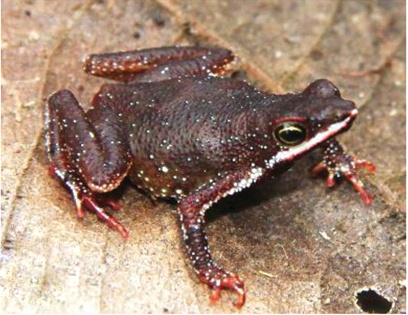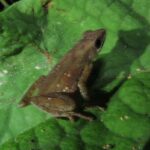The Hidden Wonders of Amazophrynella amazonicola: Guardians of the Amazon Forest Floor#
In the exquisite tapestry of the Amazon rainforest, amidst towering mahogany trees, entwined lianas, and dense underbrush, quietly resides one of nature’s smallest yet most intriguing amphibians: Amazophrynella amazonicola. Known colloquially as the Amazonian miniature toad, this inconspicuous yet captivating creature embodies the delicate balance and complexity of one of Earth’s richest ecosystems. At first glance, you may overlook them entirely, but therein lies their marvel—they thrive in unnoticed niches, quietly performing roles vital to the harmony and health of their forested kingdom.
An indigenous denizen of South America’s lush Amazon basin, Amazophrynella amazonicola presents many puzzles and peculiarities. From their distinctively vibrant coloration, secretive habits, and minuscule stature to their crucial ecological roles, this diminutive amphibian reminds us how tiny protagonists can profoundly influence the narrative of biodiversity. Let us embark on a fascinating exploration of this species, delving into their hidden lives, ecological significance, conservation challenges, and their role as a symbol of Amazonian vitality.
Taxonomy and Classification#
Erected upon centuries of rigorous biological study, the classification of Amazophrynella amazonicola anchors it firmly within the family Bufonidae—the globally diverse and widely distributed group known as true toads. First described scientifically in 1922 by herpetologist Osvaldo Rodrigues da Cunha, its classification journey illuminates critical insights on evolutionary adaptation, geography, and morphology.
Belonging to the genus Amazophrynella, a group comprising small terrestrial toads prevalent throughout the Amazon basin, this frog shares phylogenetic ties with several sibling taxa, including Amazophrynella minuta and Amazophrynella vote. Subtle but crucial morphological distinctions define these relatives, leading scientists to intensely investigate their evolutionary divergence, genetic lineages, and geographical specialization, ultimately enriching our understanding of amphibian biodiversity in South America.
Natural Habitat#
Amazophrynella amazonicola inhabits an ecological realm that vividly embodies survival amid exceptional biodiversity—the unassuming corners of the dense rainforest understory. Distributed primarily throughout the Amazonian lowlands of Brazil, Peru, Colombia, Ecuador, and Bolivia, these miniature toads thrive on shaded forest floors, often adjacent to slow-moving waterways, temporary pools, or marshy clearings.
During daylight hours, these shy amphibians find refuge beneath leaf litter, mossy logs, and decaying vegetation. Such microhabitats maintain the critical moisture levels vital for their survival, offering protection from predators and harsh climate fluctuations. Their camouflage, blending seamlessly with fallen leaves or speckled soil, further reinforces their symbiotic relationship with this cryptic environment. By twilight, however, a subtle yet profound activity arises as they silently awaken, beginning their nightly forays into hunting, mating, and interacting with this complex biome.
The perpetual humidity, stable temperatures, and intricate ecological interactions within their rainforest abode create an ideal theater for studying biodiversity, adaptation, and unique evolutionary pathways—an ecosystem profoundly reliant upon the continued survival of its overlooked inhabitants.
Physical Characteristics#
Upon closer study, the hidden beauty of Amazophrynella amazonicola reveals itself through a fascinating suite of physical adaptations. Typically measuring just 1 to 2 centimeters in length, these diminutive creatures illustrate a powerful evolutionary principle—the capacity to flourish in a world scaled much larger than themselves.
Bearing a body form compact and robust, these tiny amphibians sport finely textured skins that mimic leaf litter, bark debris, or soil granules. Vibrant yet cryptic tones of sandy-brown, gray, ochre, or muted olive often adorn their dorsal surfaces, speckled or marbled with subtle patches or lines that enhance natural camouflage. Beneath, their ventral surfaces reveal lighter shades, sometimes tinged with pink or orange hues—perhaps signaling toxicity to predators wary of brightly marked frogs elsewhere in their habitat.
The eyes, proportionally large and alert, grant excellent peripheral sight, aiding in predator evasion and prey acquisition. Their limbs, well-developed in proportion to their size, equip these toads with agile mobility over uneven forest terrain. The hardened, slightly pointed tips of their toes suggest adaptation for efficient terrestrial locomotion rather than arboreal climbing, differentiating them subtly from many other tropical frogs adapted primarily for an arboreal lifestyle.
Behavior and Life Cycle#
Under the subtle shadows cast by towering Amazonian vegetation, the daily cycle of Amazophrynella amazonicola gently unfolds. They embrace nocturnal rhythms, emerging beneath cover at dusk to feed primarily on insects and other small invertebrates. Their diet, emotively capturing notions of equilibrium, plays a quiet but invaluable role in forest health and pest control.
Mating and Reproduction#
With the onset of rains, typically aligning with seasonal climatic shifts in the Amazon Basin, the males commence their mating rituals. The male’s vocalization—a rhythmic, gentle trill, barely audible above the ambient hum of nocturnal insects and distant birdcalls—will serenade potential mates, drawing females towards carefully selected breeding sites near shallow water bodies.
Females cautiously choose healthy, well-protected sites to deposit their minute eggs, which they lay in clusters attached to submerged stems, leaves, or soil near stagnant pools or rain puddles. Embryonic and larval development occurs rapidly; within days, the eggs hatch to release tiny, vulnerable tadpoles navigating an untamed aquatic microcosm teeming with microscopic plankton and dominated by predation threats.
Metamorphosing swiftly from larvae into miniature replicas of their terrestrial parents, these juveniles quickly disperse into the leafy understory, beginning their terrestrial journey—a remarkable tale of ecological adaptation told repeatedly but invisibly beneath Amazonian canopies.
Ecological Role#
Despite their understated size and nocturnal discretion, Amazophrynella amazonicola plays an invaluable ecological role within their rainforest home. Acting notably as predators, these creatures effectively control insect populations. By maintaining these insect communities in check, the tiny toads contribute notably to the stability and health of their ecosystem, acting subtly as regulators of insect-borne pathogens and diseases.
Simultaneously, their role as prey cannot be overlooked. Birds, snakes, larger amphibians, and small mammals rely extensively on them as an essential nutritional component, underlining their relevance in the broader food web dynamics. Moreover, as highly sensitive amphibians, these small toads serve effectively as “indicator species,” signaling ecosystem health, climate disruptions, and environmental stresses—canaries in the coal mines of biodiversity, warning conservationists of changes that could cascade through broader wildlife communities.
Threats and Conservation Status#
Currently, the International Union for Conservation of Nature (IUCN) categorizes Amazophrynella amazonicola as Least Concern. Yet, despite a broadly stable status, ongoing deforestation, land-use changes, climate instability, and disease threats such as chytridiomycosis pose tangible risks to their long-term survival.
Habitat fragmentation, driven mainly by logging, agriculture, and infrastructure developments throughout the Amazon, increasingly isolates these amphibians in shrinking pockets of suitable habitat. Such fragmentation limits genetic exchange, reduces viable populations, and exacerbates susceptibility to local extinction, disease outbreaks, and climatic shock events. Continuous research, community conservation initiatives, and stricter enforcement of protected spaces will thus remain crucial to preserving this delicate species and their broader ecological contributions.
Cultural and Scientific Significance#
Although not prominently featured in traditional stories or indigenous culture due to its reclusive nature, the Amazonian miniature toad holds considerable scientific intrigue. It provides invaluable genetic data regarding adaptive ecological strategies, amphibian evolution, biodiversity conservation, habitat specialization, and climate resilience. Biologists worldwide consider species like Amazophrynella amazonicola vital subjects in ecological studies emphasizing Earth’s biodiversity dynamics and the growing effects of anthropogenic pressures.
Conclusion: Honoring Nature’s Invisible Guardians#
As we delve deeply into the captivating yet hidden world of Amazophrynella amazonicola, their great ecological importance is unmistakable. Understanding these tiny amphibians enriches our appreciation of biodiversity’s intricacy and stresses the urgency of conserving delicate ecosystems like the Amazon rainforest. Each individual effort—whether citizen awareness, habitat protection, or scientific research—underpins Nature’s magnificent tapestry, reminding us how even the smallest lives profoundly shape the narrative of our planet.









